|
Moon with a View:
Or, What Did Arthur Know… and When Did He Know it?
Part 2
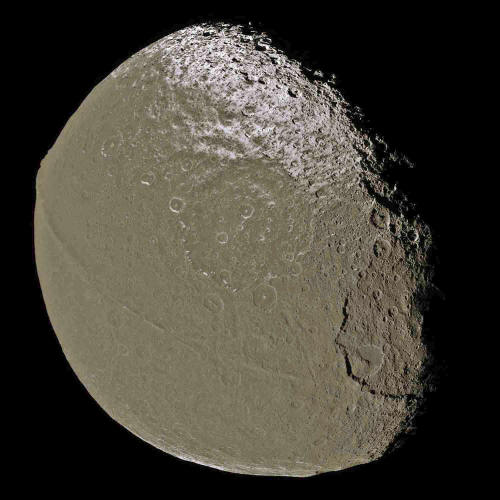
It should be obvious by now that we’ve stumbled onto something WAY
more interesting in the Saturn system than just “organic smog” … or
even “liquid methane oceans.” For what could possibly explain the
existence of extremely ancient (judging from the abundance of real
craters scattered in between …) ruins – and on such a distant,
frozen object ... a tiny satellite of Saturn with only 1/40th the
gravity of Earth–
But an extremely advanced, ancient,
extraterrestrial civilization!
Surely, because of this almost non-existent surface gravity,
combined with surface temperatures which turn water into a mineral
with the strength of steel, no innate biosphere could ever have
developed here, no evolution into living – let alone intelligent –
organisms, could ever have occurred. No breathable air ever gently
enveloped the surface of this moon, or blew as gusts of wind down
these amazing streets … or, washed the vast, surviving structures
that still tower majestically above them with a morning rain ….
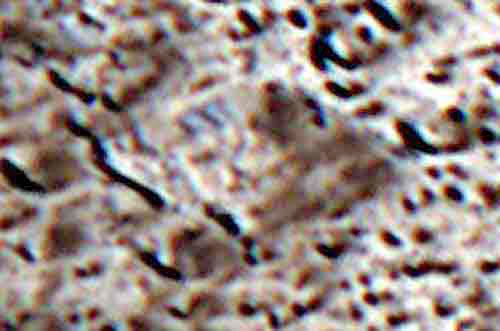
So, how can there be actual buildings on the surface of Iapetus!?
How can any of this be real?!
What if the air, which had to exist (to support the countless living
beings who must have built and occupied these thousands of square
miles of obviously designed architecture -- who … for some amazing
reason … also built “the Wall” -- was not on the outside of Iapetus
… but on the inside?
In other words -- what if Iapetus is not a natural satellite at all
... but a 900-mile wide spacecraft … an artificial “moon?!”
Before everyone starts giggling, let’s look at the mounting
evidence.
The dark, enigmatic “stain” covering fully two-thirds of Iapetus,
not only has a very “geometric” aspect (it’s a precise ellipse) … it
begins and ends in two matching “ring-shaped” features (below).
In traditional planetology, these circular “impact basins” are
attributed to explosive asteroid or cometary collisions (sometimes
the resulting excavation later partially refilling with upwelling
internal lava, producing “ring basins” around the central impact
uplift). Such features have been photographed over the years on a
variety of solar system objects, and come in a variety of sizes --
all attributed to these celestial objects – even ones only a few
miles across -- striking at hypersonic velocities, releasing their
devastating kinetic energy on impact.
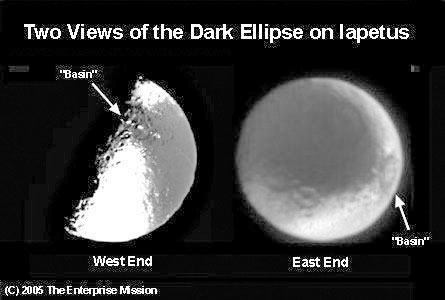
The problem with this random, external explanation for Iapetus is
that both ring-features are the same size … both lie on the Iapetus’
equator … and both are located (the shortest distance) ~120 degrees
apart (see map, below) -- precisely one third of the satellite’s
circumference from each other … one “tetrahedral” angle!
(I can hear some of you now saying -- like President Reagan did to
President Carter years ago -- “There you go again ….”)

But their tetrahedral “positioning” is a measurable fact -- and
another striking argument for deliberate design. As the odds of two
similar-sized objects randomly striking such a satellite twice, on
the equator, and precisely 120 degrees apart -- thus producing two
“coincidental” matching “ring basins” -- are infinitesimal.
These extraordinary odds are compounded, of course, by the fact that
the mysterious “dark ellipse” across the leading hemisphere
stretches 240 degrees the other way around the “planet” -- which is,
of course, two “tetrahedral angles” …. The ellipse now begins and
ends neatly at the two “rings” (see map - above) – indicating that
they are somehow “involved” with its creation.
This all argues persuasively for an internal source for both the
dark ellipse … and the rings themselves.
However, that this geometry is not some new form of internal
geological control -- modulated by the planetary
Hyperdimensional
Physics we’ve found operating on other planets – also seems clear;
neither “ring” lies anywhere near the infamous 19.5-degree
“upwelling latitude” controlled by internal “tetrahedral” forces we
see operating on other planets and their satellites. Yet, the
placement of both “ring features,” 120 degrees apart, is obviously
conveying the same “tetrahedral message” left behind in other
artificial ruins we’ve explored across the solar system ….
Finally, it can be no accident that the Great Wall neatly bisects
this ellipse … and, straight as an arrow, runs for 240 degrees …
connecting both strange “rings!”
On the side of the moon facing away from Saturn (below), after
crossing the dark elliptical expanse as a faint light line (right) …
the Wall turns into a series of brilliant (snow-covered?),
mysterious 12-mile high “mountains” (at least, that’s what NASA’s
calling them for now …) – strung out in a precise line passing
directly through (and above) the ring-shaped feature on that end of
the ellipse.
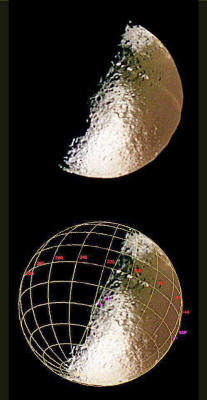
Conclusion: this remarkable string of increasingly improbable
“coincidences” is not coincidence. It is strongly arguing design.
And a “tetrahedral” design at that ….
Additional evidence supporting this (admittedly) extraordinary
hypothesis comes from examination of other regions of the surface of
Iapetus.
Here (below) is another remarkable comparison.
The image on the left is an additional wide-angle shot from the
Cassini fly-by of December 31st. The image in the right reveals the
remarkable distribution of same-size “craters” newly imaged on
Iapetus – “coincidentally” arrayed at roughly equal distances from
each other, and … all on the same “latitude” … parallel to the Great
Equatorial Wall!

Needless to say, the idea that an array of same-size comets or
asteroids somehow randomly “chose” to all fall (over billions of
years) on exactly the same line, separated by almost equal distances
(!) – and … exactly parallel to the Iapetus’ equator -- is just
silly.
A close-up of one of these “craters” (below) -- located on the
western rim of the large impact basin in the center of the disc
(above) -- reveals that the “crater” is, in fact, another major
architectural form. It is part of an array of equally incredible
geometric architecture ... and, other than being approximately
“round” … with its uniform-width, “castle-like walls” and geometric
interior, does not morphologically resemble actual impact craters
imaged anywhere else in the solar system! In addition, if you look
closely toward its “top” (as seen in this close-up image - below),
the line of geometric patterns proceeding toward it from the right
passes uninterrupted right through the “crater” floor – indicating
that, in fact, the “crater” is part of a set of pre-existing
structures.

If I am correct, what we are seeing as “geometrically arranged
craters” on Iapetus are, in fact, structurally-defined surface
collapse features – revealing key weak points in the basic
sub-modules of this “artificial moon.” It stands to engineering
reason that such a huge “world structure” would be assembled
fractally – by building it up from multitudes of identical, smaller
units – using the fundamental principal of the “tetrahedral truss.”
This, of course, was the secret of
Buckminster Fuller’s famed
“Geodesic Domes” (below).

The “latitudes” along which these major sub-units are arranged on
Iapetus seems to be determined by the structural strength each one
contributes to the integrity of the overall “spherical moon.” And
the basic geometry of each major sub-unit (how they collapse …) is
revealing the geometric nature of the sub-modules themselves ….
If you look again at many of the “craters,” you can see that they
are, in fact, deformed hexagons (below).
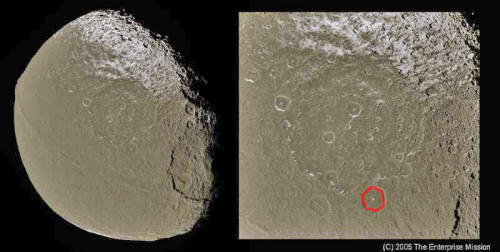
This strongly indicates that, as the surface of Iapetus has been
eroding (from the incessant onslaught of micrometeorites, over
untold millions of years …), the larger structural geometry
literally holding it together – on a variety of scales – is
repeatedly revealed … exposing the fact that this fundamental
structure is essentially the same geometry that defines a geodesic
dome – a replicating tetrahedral pattern (below)!
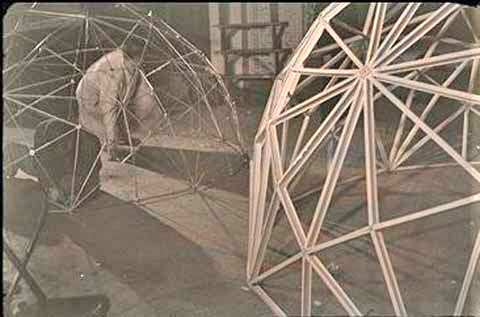
The largest visible example of this intrinsically tetrahedral form
is the ~240 mile-diameter basin in the center of the image (below).
It too has a basic hexagonal geometry – more supporting evidence for
the “two-dimensional, six-sided, sub-module assembly model” for the
surface of this entire “moon.” As can be seen, smaller collapse
features within it (and beside it) are also eroding according to
this basic tetrahedral form ….

A close-up of the vertical, 12-mile drop -- from the rim to the
floor of the major basin (below) -- reveals a series of serrated,
evenly-spaced “teeth” (similar sized fragments of former structural
walls ...) sticking at right angles outward into space from this
eroding feature ... creating a series of parallel, ~60,000 foot
cliffs. On the basin floor itself, a series of aligned, 90-degree
eroded features is also clearly visible (running from lower left to
upper right – below) ….
These are all redundant indications that the smaller structural
sub-units are, indeed, being fractally eroded backward from the
basin center … along each of the six, hundred-mile-long, hexagonal
“rim walls.”

By contrast, on the northwest cliff of this ~240-mile-wide basin,
the ancient blast wave has revealed a very different array of
impossibly massive, engineering-looking structures (marked below).

In close-up, the strikingly geometric -- but very different nature
-- of this “mega-engineering” is exposed ….
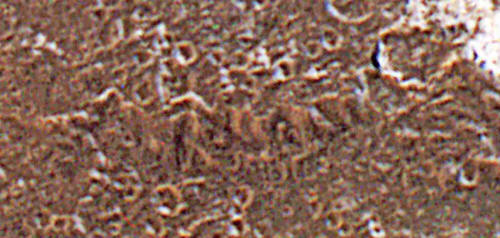
These appear to be some of the incredibly imposing, main structural
elements of this small “moon” – a “keel” as it were -- apparently
uncovered by whatever impact destroyed the surface here – still
aligned over literally hundreds of miles north/south -- exactly
90-degrees to Iapetus’ equator (out of frame – left).
Other forms
(below) are eerily twisted into massive, but still “geometric,”
wreckage … mute testimony to the inconceivable energies released
against this almost “god-like” technology … a long, long time ago.

All of which confirms what the two giant “rings” – carefully
positioned 240 degrees apart at opposite ends of the mysterious dark
ellipse -- were obviously trying to communicate--
That Iapetus is not one of the normal “moons” of Saturn -- but is
actually a 900-mile-wide, manufactured, ancient world-sized
spaceship ... created under 1/40th terrestrial gravity according to
a fractally apparent, “tetrahedral” pattern!

Nothing else makes sense.
Once you realize, from these extraordinary images, even the
possibility that what we’re seeing is not natural, that we aren’t
dealing with a “world” at all -- but with a world-sized ship! -- the
supporting evidence is everywhere ….
At low incidence lighting over other regions (for instance, near the
major impact basin on the right – below) one cannot help but look
again at that remarkable, rectilinear “waffle” pattern. The
explosive formation of that basin to the north would have also
totally destroyed any former “surface covering” here as well --
exposing massive inner structural supports.
In fact, if you look carefully along the terminator in this region
(to the right – below) -- that seems to be exactly what we’re
seeing!

Close examination reveals a definite “grid” crisscrossing this
region … apparently composed of several angled layers of overlying
structural “rebar” -- but on an incomparably massive scale ….
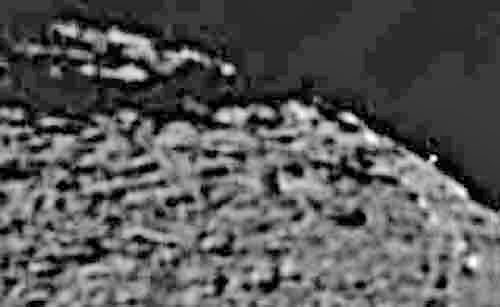
Because the human eye/brain combination recognizes linear patterns
far better at some angles than at others, when we rotate the image
90 degrees counterclockwise (below) -- the obvious exposed and
layered nature of this “moon” really stands out … as a series of
long, linear features which seem to be major structural support in
this region for the (now destroyed), overlying “terrain” (below) ….
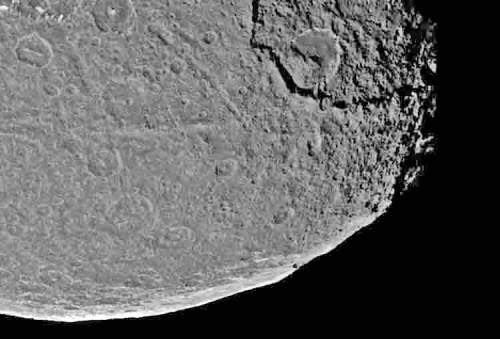
A closer view ….

The unique and obviously layered nature of Iapetus -- a “shell …
within a shell … within a shell” is truly revealed here (below): the
“cookie cutter” geometry of this eastern “impact basin” (seen here
from a different angle to the previous image) is totally unlike that
of any other impact features known ... on any other planet, or
satellite across the solar system!
The essentially vertical, ~12-mile cliffs (curiously similar to the
“12-mile elevation” of Iapetus’ “Great Wall”), plunging down in
discrete steps – as if whatever gargantuan explosion ripped thorough
the surface, exposed successive shells of now heavily eroded,
layered Bucky Fuller architecture – says it all.
As does the repeating pattern of underlying liniments and
right-angle geometry … across each successive shell.
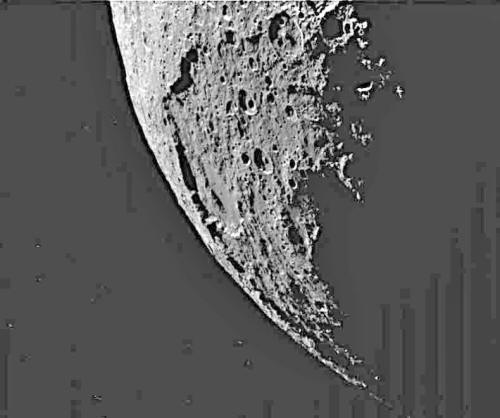
These are the shattered, blasted remnants of an ancient, almost
incomprehensible science and technology … stark, surviving evidence
of a “super-engineering” that once held together an entire world …
and for some reason, placed it in the Saturn system.
At the top of Part I you might have noticed one of the first Cassini
images of Iapetus, taken last October. This was done deliberately …
to see if anyone would, early on, pick up on the most blatant, most
startling piece of planetary evidence we’ve found supporting
“artificiality” for Iapetus. The most “in your face” view (sorry …)
that NASA ever has released (below)--
This image.
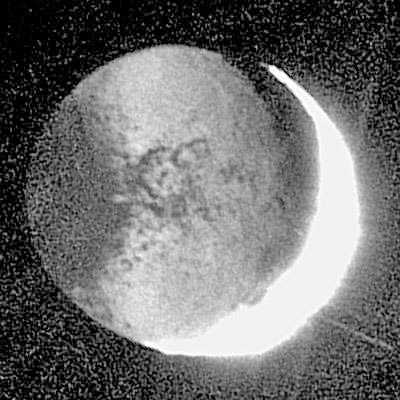
To properly begin the analysis, there are several additional things
you need to know -- starting with
how the image was acquired.
The Cassini spacecraft took this time-exposure by the light of
“Saturn shine” – via the reflected glow of the Ringed Planet,
shining on the hemisphere of Iapetus that always faces it, from
across more than two million miles ….
In this view, acquired by Cassini from just under half that
distance, in October 2004, the eastern side of our familiar “dark
ellipse” is toward the left – terminating in one of the two
remarkable “ring-shaped” features discussed earlier. This eastern
“ring” – and an extremely provocative, aligned “rectilinear
geometry” completely surrounding it – is located near the center of
the hemisphere we’re looking at.
What’s most interesting about this “ring-feature” is how the ~220
mile diameter “array” – and everything surrounding it -- seems
oriented … east/west, north/south.
But the most startling feature of this unique, nighttime record is
the overexposed, sunlit portion of Iapetus’ surface – to the right.
Look very carefully. Do you see what is blatantly apparent -- an
aspect of this exotic “moon” which simply should NOT exist … unless
we’re right?
Here is a
comparison graphic to assist you (below).
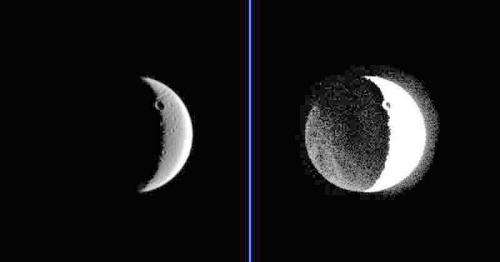
This Cassini image (above-left) is of another Saturnian moon -- also
first seen as a mere dot of light in Cassini’s small refracting
telescope over three hundred years ago – another of the “Titans” …
the moon Dione. Taken by the spacecraft narrow-angle camera from
about 800,000 miles away, this image is a “normally” exposed view.
Dione is about 200 miles smaller than Iapetus, at only 695 miles
across. Its icy surface is also covered with a variety of craters,
from untold years of random impacts. Dione, like Iapetus, also
revolves and rotates around Saturn synchronously -- one hemisphere
always facing the primary planet, the other die forever turned away.
Note how the sunlit hemisphere in this image is well-illuminated,
with a few of the larger craters showing deep shadows, while the
opposite (Saturn-facing) hemisphere is currently in total darkness.
The second image (above-right) is a “time exposure” of the same
view, taken a few seconds later. It was produced by integrating the
faint light reflecting off Dione’s nightside hemisphere, utilizing
the “Saturn shine” time-exposure technique described above. The
result is a faintly-illuminated view of the previously invisible,
Saturn-facing hemisphere.
As with the Iapteus shot, the (totally overexposed) sunlit landscape
is on the right ….
What is critical for properly completing this analysis is to take
careful note of the shape of
Dione’s overexposed sunlit surface.
Even under its low surface gravity (approximately that of Iapetus’ –
about 1/50th that of Earth), the mass of ice and rock making up
Dione (with a density of about 1.5 times that of pure water) has
obviously crushed this mass into essentially a perfect sphere.
Then, there’s tiny Mimas (below) – another Saturnian moon, this one
only 247 miles across ... less than the size of some of the major
impact basins on Iapetus (note the Saturn shine on the left of the
enlarged inset image …)!
Mimas' surface gravity is only 1/150th that
of Earth (a little under 1/4th that of Iapetus) … yet it too is
almost spherical; the difference being a slight “egg-shaped”
distortion in the direction of Saturn (below – inset) – created by
“solid-body tides” raised in Mimas’ surface, caused by Saturn’s
immense gravitational attraction a mere ~115,000 miles away.

Which is the obvious point here: something is radically “wrong” with
Iapteus … compared to Mimas or Dione ….
Despite having a larger gravity field and much more mass … and being
over 2 million miles from Saturn (so “tides” are totally eliminated)
…its overall shape isn’t close to being spherical!
Look again at the “Saturn shine” image of Iapetus (below-left). In
the overexposed sunlit portion, the limb of the moon – rather than
being round (like Mimas or Dione) – is plainly composed of a set of
sharply slanted planes (below-right) …. The exact number is
difficult to reconstruct (because of the overexposure and the
viewing angle), but the outlined areas appear to mark at least six
(tetrahedral?) amazingly flat “sides” – each measuring hundreds of
miles in length!
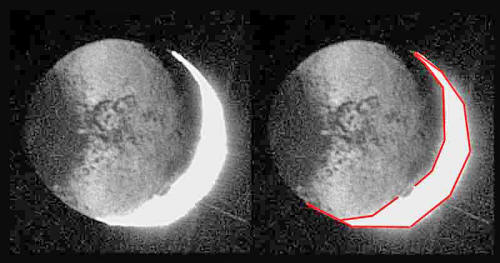
Needless to say -- natural planets or satellites do NOT come with
sharply-defined “straight edges!”
And before anyone says, “Oh, that’s just a smeared photo,” I would
remind them of the official
NASA press release that came with it,
which plainly states:
… The image shows mainly the night side of
Iapetus; part of the far
brighter sunlit side appears at the right and is overexposed due to
the long integration time of 180 seconds. Despite this long exposure
time, almost no blurring due to the spacecraft’s motion is apparent
[emphasis added].
What this means, of course, is that the stark, “impossible”
straight-edged geometry we’re seeing on Iapteus’ limb … is real!
In October, following the just-discussed testing of this technique
on Dione, Cassini was commanded to take
a much more extensive series
of similar long-exposure images of Iapetus … over a period of
several days (below).
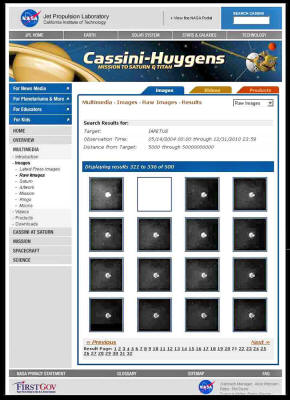
Since one or two images would have sufficed to show the surface
features under “Saturn shine,” the fact that Cassini took over a
hundred distant images (below) -- as both the spacecraft and the
“moon” moved inexorably further around Saturn -- indicates to me
that NASA also strongly suspected -- in October -- what we’ve just
discovered: that Iapetus, for some reason, is NOT a “spherical” moon
….
In fact … that it’s not a “moon” at all!
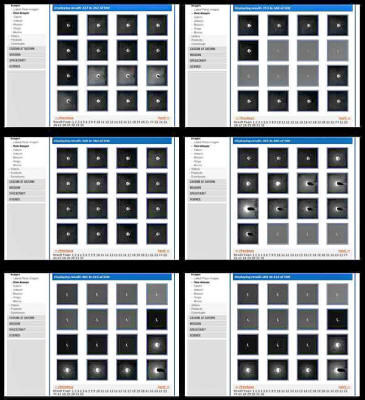
If you take one of
the first images in this curious sequence
(October 20th), and
one of the last (October 22nd) -- and compare
them (below) -- you instantly see that the angle of perspective (due
to the relative orbital motions of the “moon” and Cassini)
significantly changes in this two-day period. A careful comparison
of these perspective changes unequivocally shows that – whatever is
causing the “flat” geometry on this bizarre “moon” – is changing in
a three-dimensional manner totally consistent with the changing
viewing geometry ….
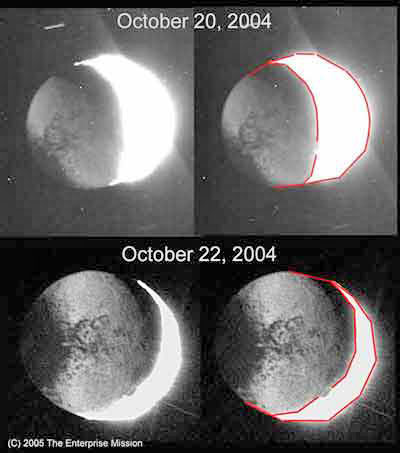
In other words, this is a completely independent check (beyond
NASA’s own official statements) – on whether the over-exposed,
“straight-edged geometry” we’re seeing on the sun side of Iapetus is
simply an imaging “artifact” -- due to “blurring.”
It is NOT.
As I gazed at this astounding image, something about it was eerily
familiar ….
Then it hit me: this was the same geometric shape (below) that
H.G.
Wells – that famed Victorian science fiction writer, who also left
us immortal classics like “The Time Machine,” and “The War of the
Worlds” -- had proposed for his own spaceship … in “First Men In the
Moon” (1901)!
(Which brings up the nagging question: what did Wells know … and how
did he get wind of it ..!?)

Such a shape, of course -- in two dimensions (as a silhouette or
projection) -- is structurally derived from one of the more complex
three-dimensional “Platonic Solids” (below) – the only regular
polyhedral (“many sided”) geometric forms which will fit perfectly
within a sphere ….

In this case, apparently an irregular polyhedron based on the …
dodecahedron (below).

The appearance of this startlingly regular geometry on a Saturnian
moon – but only (at least, at this angle) on the sunlit side, and
only with sufficient overexposure of the image – was a crucial clue
to the physics of this whole “impossibility.”
If this one-time “spaceship moon” was originally constructed along
the geometric lines of a higher Platonic Solid (icosahedron …
dodecahedron … some variant thereof …), eons of micrometeorites
(according to the apparent ancient age of this astonishing object …)
would have preferentially eroded the exposed vertices of such a
polyhedron … inexorably whittling away at the highly angular
structure, until what remained (under normal lighting) resembles
more or less a sphere!
Only sufficient camera overexposure, at the immense distance of
Saturn from the Sun, can reveal Iapetus’ original geometry -- by
enhancing the faint scattering of sunlight still reflecting from
those parts of the Iapetus’ former structure still “hanging in the
sky” … above the long-eroded surface of this ancient “moon” …. In
other words, more of what we have already seen above Iapetus’ polar
regions (below).
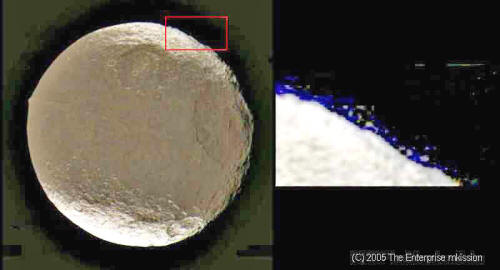
This was why the over-exposed, sunlit limb of Iapetus in the “Saturn
shine” Cassini image – as a two-dimensional projection of a
three-dimensional Platonic Form – must reveal in silhouette the
original three dimensional geometry of this “artificial moon”
(below).
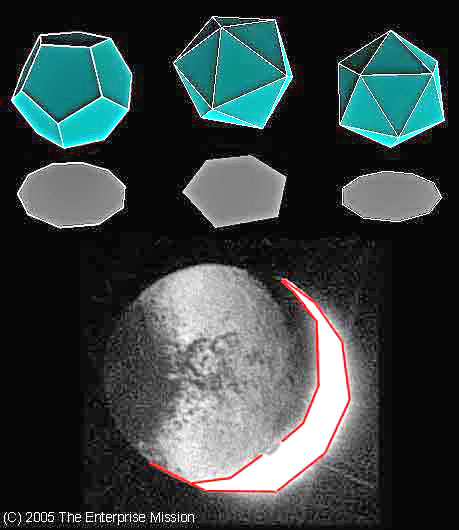
This is compelling evidence – and on a planetary scale (below) –
that Iapetus was, in fact, constructed … as a geodesic moon.
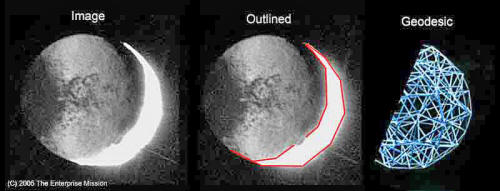
Additional confirmation of this astonishing geometry – and the
entire “tetrahedral moon hypothesis” -- is visible in other images
as well ….
A set of mosaiced, narrow-angle Cassini images of
Iapetus -- taken
as the spacecraft passed much closer to this extraordinary satellite
(within 80,000 miles, during the December 31 encounter) – revealed a
magnified straight-edged aspect to the moon’s horizon
(enlargement-below, top).
Appearing as if the image was actually
taken on a Hollywood soundstage! – with the sharp, angled horizon
(enlargement-below, bottom) the result of “forced perspective” on a
set – in fact, the Iapetus image turned out to be a much
higher-resolution example of the same, impossible “geometric planes”
seen in the distant “Saturn shine” October images!

Again … natural satellites do NOT come with hundred-mile-long
“facets!”
The fact that this startling “straight edge” geometry is clearly
evident on a normally-exposed image of the dark, leading hemisphere,
seems to be trying to tell us something quite significant …
particularly, about external erosion taking place on the two
different hemispheres of this increasingly perplexing “moon.”
One of the prevailing models for the Saturn system proposes that
micrometeorite erosion is enhanced on the leading hemisphere of the
synchronously rotating satellites – due to the simple fact that the
moons’ orbital velocities around Saturn (and, at certain times,
around the Sun) add to the speed (and thus destructive energy …) of
any impacting objects “on the front.”
The fact that we’re seeing stark evidence of Iapetus’ original
ground-level plane geometry in this leading hemisphere (while such
remains have almost disappeared in the trailing hemisphere – and are
only visible now in lengthy time-exposures), would at first seem to
be a major contradiction – both for the meteorite theory … and the
age of the original geometry itself. In fact, the visibility of such
remains should be exactly the other way around: they should much
better-preserved in the one place shielded from such constant
micrometeorite abrasion … on the trailing hemisphere.
However, if Iapetus has not always kept its darkened hemisphere
aligned with its orbital motion around Saturn -- as seems the case
with several other of Saturn’s moons (they’ve apparently
reversed
their orientation over the lifetime of the solar system, several
times -- due to large, external impacts …), then perhaps Iapetus’
now leading hemisphere … was once facing in the opposite direction
(below)!

If that’s the case, then the discovery of surviving straight-edged
geometry at ground level in the current leading hemisphere could be
another means of unraveling the deepening mystery of the “dark
ellipse” itself.
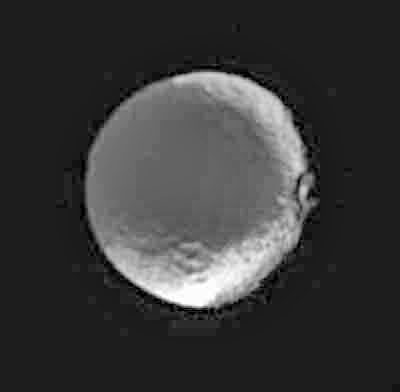
Another mystery that the discovery of Iapetus’s bizarre Platonic
Geometry could solve, is the reason for the precise placement of the
two “ring basins” -- 240 degrees apart, at the east and west ends of
the front hemisphere “ellipse.” If Iapetus is in fact an artificial,
now anciently eroded, dodecahedron (or a higher order “geodesic
sphere”) – then, the “tetrahedral” siting of these two strange
“rings” suddenly makes perfect sense!
As can be seen (below), if a tetrahedron is placed inside a
dodecahedron, its vertices can also be precisely placed on select
vertices of the dodecahedron itself. This, in turn, generates a
“lowest order solution” to the puzzle of why the two “impact basins”
marking the Iapetus ellipse would be located on the surface
according to a tetrahedral geometry.
The answer: they aren’t “natural impact basins” after all -- but
more ancient, geometric evidence that Iapetus was once a
Platonically-designed … world-sized … spaceship “moon” ….

Click Here for Part Three
→
|





































